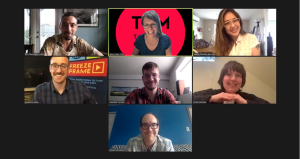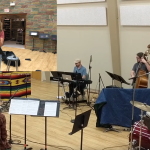Story Seekers: Myriam Benzakour-Durand and Blanche Israël
Person interviewed: Alison Palmer, school programming and training
Interview date: July 12, 2021
Théâtre Cercle Molière (TCM) is a theatre company approaching its centennial anniversary. Established in Winnipeg in 1925, it aims to use francophone theatre and culture to bring Manitobans together. TCM considers itself one of the major drivers of Franco-Manitoban cultural life.
For more than 50 years, in addition to its regular programming, the Théâtre Cercle Molière has offered its annual Festival théâtre jeunesse (FTJ), featuring theatrical creations, celebrations, and opportunities for pre-secondary and high school students to interact with each other. During the week-long festival, about 30 francophone schools participate in a valuable and rewarding experience that introduces them to the theatre arts and invites them to create plays, while also giving Franco-Manitoban youth a chance to network with their peers.
The Innovations: An inaugural virtual festival and closer working relationships with teachers
Before the pandemic, the groups gathered at the Centre culturel franco-manitobain to present their plays in front of the other schools, receive feedback from a jury, and participate in a week of celebrations. During the week of the festival, two days and two evenings are devoted to the middle school students (7th to 9th grade), followed by two days and two evenings for the high school students (10th to 12th grade). The festival culminates in a gala on Friday night, featuring an awards ceremony, music, and a special theme.
In 2021, TCM was determined to offer at least one version of the FTJ, despite the pandemic. As Alison Palmer, director of school programming, explained, “Regardless of the number of registrations, regardless of the format, we knew we wanted to offer a space where people could share their creations and meet other young people.” The festival still didn’t have a website, so TCM’s first step was to create an online platform for the festival, with a voting zone, a section for photos, and a chatroom that allowed the students to share their bloopers and behind-the-scenes moments, encouraging their peers to view and vote for their projects.

“From the beginning,” Alison said, “we had to consider the fact that it would have to be filmed if we weren’t going to be able to get together in person.” So TCM forged a brand-new partnership with Freeze Frame, a media arts centre for young people in Manitoba that presents the International Film Festival for Kids of All Ages each spring, in which youth learn to create short films.
TCM and Freeze Frame joined forces to offer all interested schools a series of six workshops to prepare for the FTJ, three of which were focused on filmmaking (screenwriting, filming, and editing), and three of which were focused on theatre (playwriting, acting, and staging). Altogether, more than 75 virtual workshops were presented to more than 450 students.
The workshops led up to the virtual FTJ, which took place in May 2021 and presented 19 filmed projects on the festival website. The youth could view the films, give each other scores, participate in the chat, and attend the gala, which included an awards ceremony, on Friday night on Zoom.
Alison said that, for TCM, “working on these platforms was entirely new. It really pushed us.” However, she feels that it was definitely worth the effort and that they will retain at least some of the format in the future because being virtual means it’s widely accessible. “We like to be there in person, but that isn’t always possible,” she said. Thanks to the virtual format, for example, “there are schools in very remote locations that would like to benefit from our training, and this offers them a good alternative.”
TCM adapted to the new technologies in house, whereas it went out of house for the expertise required to present a top-notch gala. “We learned how to use the platforms. We only hired other people for our gala. We did a livestream, it was super cool. We could see that the young people were really excited.” The awards ceremony was planned so that it would be similar to the in-person version, with a dynamic host who encouraged the youth to dance. Each student could be seen in their own Zoom frame dancing and participating in the event. “I don’t think we could get any more real than that,” Alison said.
The Challenges: Adaptations and community consultations
In order to prepare for the event, TCM had to forge even closer working relationships with the teachers throughout the school year. “We had to support the teachers, have a lot of [one-on-ones], phone calls, emails,” Alison noted. This allowed TCM to shape its virtual festival. Alison said, “The other version of the FTJ was really a well-oiled machine. There weren’t that many consultations,” whereas the new version of the FTJ required us to constantly adapt and give it more special attention. “Are the students at home? At school? Half and half? If they’re at school, do they each have their own screen or are they all in front of the same computer for the entire class? We really had to adapt,” Alison explained. The need for follow-up was greater. “We trained the teachers, we equipped them. There was a lot more follow-up where we could see the progress of each school and talk about it.” The feedback and follow-up with the teachers and students was an aspect of the virtual festival that Alison would like to keep in the future.
Regarding the difficulties presented by the project, Alison adopted an improvisational philosophy that is typical of her artistic field. “There were some mistakes,” she said, “but it’s like in theatre – when you miss a cue, that’s what makes it human and real. It was touching to think back on it later. It wasn’t all perfectly polished.”
The Financials: Preparing for unexpected costs and providing visibility for the sponsors
Alison stressed that, even during a normal year, “the FTJ was never an activity designed to make money.” The festival depends on funding, grants, sponsors, and partners. The new virtual festival did not lose money, despite the fact that it was offered free of charge to schools for the first time in its history. “Everything was well planned, and we stayed within our funding budget. We were able to offer it for free, with some great gifts [for the students] at the end.”
However, Alison explained that there’s no guarantee of lower costs when you make this kind of festival virtual. “It costs just as much, if not more, because you have to consider the technical equipment, the creation of the videos for the website, the company we hired for the gala, the free workshops. All these little things add up.”
In terms of visibility, they had to find new ways to recognize donors. The organization created a donor recognition section on the new festival website to highlight the contributions made by sponsors and public funders. In addition, the virtual awards ceremony was a new showcase for donors. “Everyone who awarded prizes at the gala was a sponsor,” Alison remarked.
There were promotional benefits to making the project virtual. The traffic on the FTJ website gave TCM the opportunity to publicize its other projects, such as its Marathon de création, and encourage young people to participate in them.
The Takeaways: A hybrid format, an increase in community consultations, and non-traditional partnerships
Alison anticipates that the FTJ, which was without a website before the pandemic, will be presented as a hybrid event from now on, with an in-person gala with the option to attend remotely. A hybrid format would allow the festival to lower the costs for the schools, while still maintaining the collective creative spirit. “It’s true that a workshop where you act, where you create, it’s fun to be there [in person]. But so much is possible [in a virtual format] with smaller budgets from the schools. No need to have an artist come in, for example.”
After doing festivals for 50 years, the organization had lost the habit of consulting with the various parties involved. “That’s maybe something that was missing,” Alison said. The benefits of ongoing consultations with the participating teachers and students were undeniable. The student committee, the surveys of representatives at each school, and the one-on-one meetings with the teachers will be retained in order to evaluate the festival’s success as well as to consider changes in the future.
Alison noted that the pandemic gave the FTJ the opportunity to open up to partnerships and collaborations that either hadn’t been possible or had never been considered before. “There is always a solution, maybe not the one we’re used to or the one that has always been the best. Sometimes it’s good to get completely away from what we’re accustomed to doing to see the possibilities.” By being open and communicating with other organizations who have a similar vision, she found that they could easily align with each other and create something new together.






